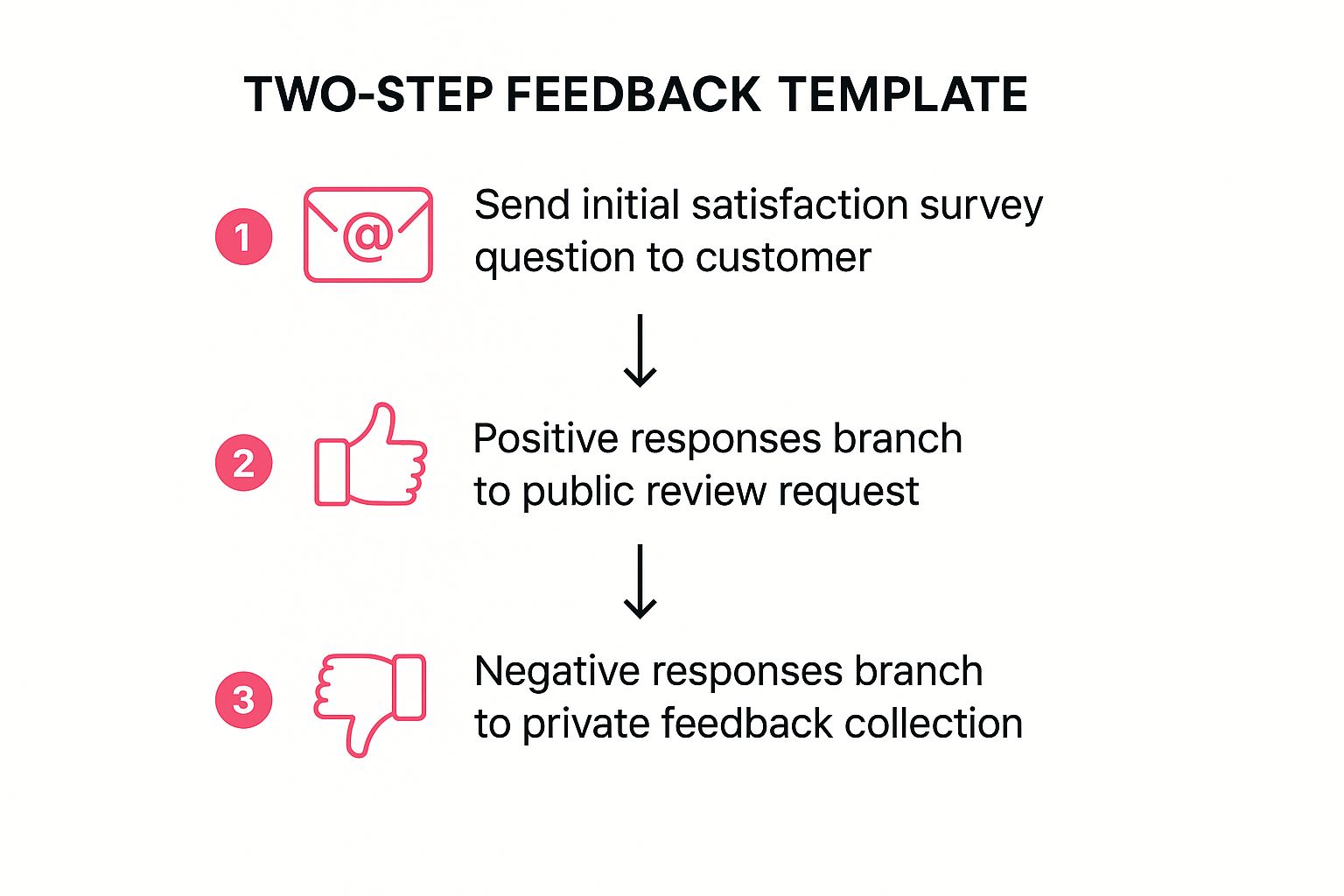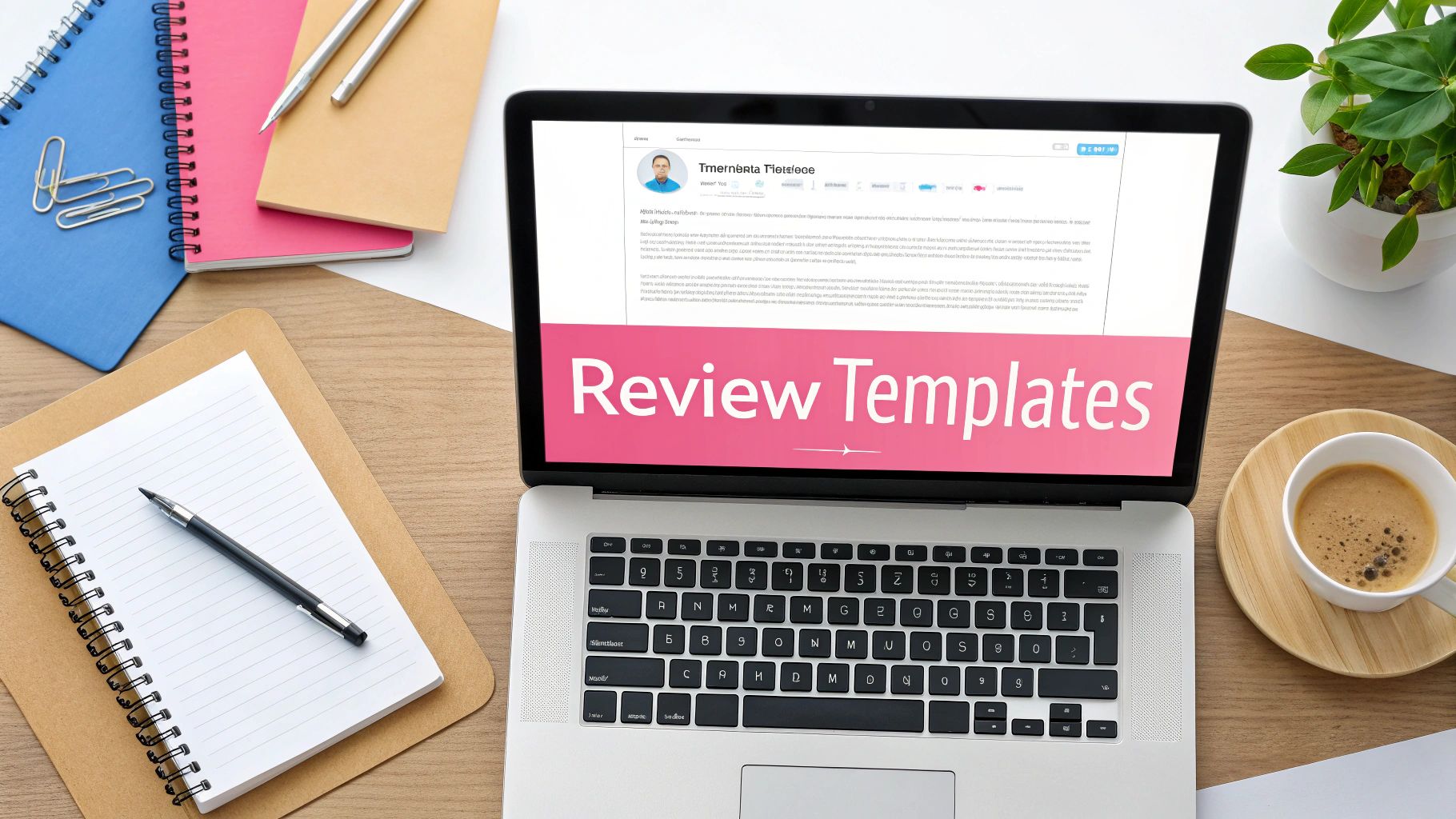Table of contents
Asking satisfied clients for a review can feel awkward, but it's a vital task for any service-based business, from car detailers to digital agencies. Positive reviews build trust and act as powerful social proof, directly influencing potential customers and driving growth. The challenge isn't just asking; it's asking effectively. A poorly worded request gets ignored, but a well-crafted review request email template can significantly boost your response rate.
This guide moves beyond generic examples. We will dissect seven distinct templates, providing a strategic breakdown for each one. You'll learn not just what to write, but why it works and how to adapt it for your specific industry, whether you're a mortgage broker or an accountant. Before you start sending requests, it's wise to have a solid framework for measuring client satisfaction, as reviews are just one piece of the puzzle.
Our focus is on actionable tactics. For each template, we'll analyse the core strategy, highlight key psychological triggers, and provide clear takeaways you can implement immediately. By the end, you'll have a complete toolkit of proven templates to confidently and systematically gather the powerful testimonials your business deserves.
1. The Simple Direct Ask Template
Sometimes, the most effective approach is the most direct one. The Simple Direct Ask is a foundational review request email template that gets straight to the point. It strips away fluff and complex persuasion, relying instead on clear, concise language to ask a satisfied customer for a review. This method’s power lies in its simplicity and respect for the customer's time, making it incredibly effective for businesses across various sectors, from car detailers to digital agencies.

Pioneered by e-commerce giants like Amazon and perfected by service apps like Uber and Airbnb, this template capitalises on the moment a customer's satisfaction is at its peak. It works by sending a timely, personalised, and unambiguous request, making the "what" and "why" immediately obvious to the recipient.
Strategic Breakdown
This template is built on three core principles: timing, clarity, and ease of action. The goal is to minimise friction. When a customer has just had a positive experience, their willingness to share is highest. A direct, easy-to-understand email with a single, prominent call-to-action (CTA) button makes it effortless for them to follow through.
Key Insight: The less a customer has to think, the more likely they are to act. This template removes cognitive load by presenting a single, simple question: "How did we do?"
Actionable Takeaways
To successfully implement this review request email template, follow these best practices:
- Deploy Swiftly: Send the email within 24-48 hours of the service completion (e.g., after a car detailing session) or product delivery.
- Personalise the Subject & Greeting: Use the customer’s first name (e.g., "Hi Sarah,") and mention the specific service or product. For example, a subject line could be: "How was your recent mortgage consultation?"
- Make the CTA Unmissable: Use a brightly coloured, contrasting button with a clear, action-oriented label like "Leave a Review" or "Rate Your Experience".
- Keep it Mobile-Friendly: A significant portion of your customers will open this email on their phones. Ensure the layout is clean and the button is easy to tap.
This straightforward approach is a vital tool for any business looking to build social proof. For more strategies on crafting the perfect request, you can learn more about asking customers for reviews on TestimonialDonut.com.
2. The Gratitude-First Template
Leading with gratitude is a powerful way to foster a positive connection before asking for anything in return. The Gratitude-First review request email template prioritises expressing genuine appreciation for the customer's business. This approach softens the request by building an emotional bridge, making the ask feel like a natural continuation of a positive relationship rather than a purely transactional demand. It's particularly favoured by small businesses, Etsy sellers, and service providers who build their brands on personal connections.

Popularised within artisan communities and service-based professions, this method acknowledges that customers have a choice. By thanking them specifically for choosing your business, you validate their decision and make them feel valued. This small act of recognition significantly increases their willingness to reciprocate with a positive review, turning a simple transaction into a moment of mutual appreciation.
Strategic Breakdown
This template operates on the psychological principle of reciprocity and emotional connection. When you give something first, even something as simple as a heartfelt thank you, people feel a natural inclination to give something back. The strategy is to frame the review not as a favour to the business, but as the customer's opportunity to share their valuable story, which began when they chose you.
Key Insight: A customer who feels seen and appreciated is more likely to become a vocal advocate. Gratitude shifts the dynamic from "What can you do for me?" to "We appreciate you, and your feedback matters to us."
Actionable Takeaways
To make this review request email template work effectively, focus on authenticity and specific details:
- Be Genuinely Thankful: Start the email with a clear expression of gratitude. Phrases like "Thank you for choosing us for your recent home loan pre-approval" are far more effective than a generic opening.
- Reference the Specifics: Mention the exact service provided (e.g., "your quarterly BAS lodgement") or product purchased. This shows the email isn’t an impersonal, automated blast.
- Keep the Tone Warm: Use language that is professional yet warm and human. This reinforces the idea that there are real people behind the business who value their custom.
- Provide an Easy Out: Always include clear contact information for customer support. This gives customers a direct line to resolve any issues privately, preventing potential negative feedback from being posted publicly.
3. The Social Proof Template
Humans are social creatures who often look to the actions of others to guide their own. The Social Proof Template is a powerful review request email template that leverages this psychological principle. It subtly encourages customers to leave feedback by showing them that many others have already done so, creating a sense of community and shared responsibility. This approach frames the act of reviewing not just as feedback for the business, but as a helpful contribution to fellow consumers.

This method was popularised by community-driven platforms like TripAdvisor and Yelp, which built their empires on user-generated content. Amazon also uses a variation of this by highlighting how reviews help other shoppers make better decisions. For service-based businesses like mortgage brokers or buyer's agents, this template can be incredibly effective in showing prospective clients that they are a trusted and popular choice.
Strategic Breakdown
The strategy behind this template hinges on two psychological triggers: social proof and altruism. By mentioning the number of existing reviews, you signal popularity and trustworthiness. By emphasising how a new review will help others, you appeal to the customer's desire to be a helpful member of a community, transforming a simple request into a meaningful action.
Key Insight: Customers are more motivated to act when they feel their contribution has a tangible impact on others. This template positions the reviewer as a knowledgeable guide for future customers.
Actionable Takeaways
To effectively implement this review request email template, focus on making the social proof compelling and genuine:
- Be Specific with Numbers: Instead of saying "many customers," use concrete figures like "Join over 250 happy clients who have shared their experience." Update this statistic regularly to maintain credibility.
- Show, Don't Just Tell: Include snippets of diverse, positive reviews or a visual element like a 5-star rating graphic. This provides immediate visual confirmation of customer satisfaction.
- Highlight the "Helpfulness" Factor: Use phrases like "Your feedback helps others choose the right digital agency" or "Help another homebuyer make a confident decision."
- Emphasise Credibility: Mention the review platform by name (e.g., "Leave a review on Google"). This adds a layer of trust and directs the customer to a familiar space.
4. The Two-Step Feedback Template
For businesses that want to be more strategic with their reputation management, this sophisticated review request email template adds a crucial intermediate step. The Two-Step Feedback Template first gauges customer satisfaction before asking for a public review. This intelligent filtering mechanism directs happy customers to platforms like Google or industry-specific sites, while funnelling unhappy customers to a private feedback channel. It’s a powerful method for maximising positive social proof while capturing valuable insights for internal improvement.
This approach has been widely popularised by SaaS companies like HubSpot and is a core concept behind the Net Promoter Score (NPS) methodology. It allows businesses, from buyer's agents to accountants, to proactively manage their online reputation instead of simply reacting to it. By creating two distinct paths based on initial feedback, you can protect your brand and improve your service simultaneously.
Strategic Breakdown
This template's strategy is built on segmentation and damage control. Instead of sending every customer down the same path, it intelligently routes them based on their sentiment. The initial question acts as a gatekeeper, ensuring that your public review profiles are populated primarily by advocates, while giving you a private, constructive channel to resolve issues with detractors.
Key Insight: Proactively identifying unhappy customers turns a potential one-star review into a priceless opportunity for service recovery and operational improvement.
This flow chart visualises the customer journey, from the initial satisfaction query to the two distinct outcomes based on their response.

The diagram clearly illustrates how a single email can trigger two very different, but equally valuable, results.
Actionable Takeaways
To successfully implement this review request email template, focus on seamless execution and follow-through:
- Use a Simple Question: Start with a binary or scale-based question like "How was your experience?" using thumbs up/down, stars, or a 1-10 scale.
- Automate the Routing: Set up your email system to automatically send a different follow-up based on the customer’s answer. Positive responses get the public review link; negative responses get a link to a private feedback form.
- Respond to Negative Feedback Immediately: The value of this system lies in service recovery. Have a process in place to ensure a team member follows up on negative feedback within 24 hours.
- Track Both Paths: Monitor the conversion rates for both positive reviews and the amount of private feedback collected to measure the template's effectiveness.
This method provides a robust framework for managing customer sentiment. You can find more details on how to ask for feedback on TestimonialDonut.com.
5. The Incentive-Based Template
Offering a tangible thank you for a customer's time can dramatically increase review conversion rates. The Incentive-Based Template is a powerful review request email template that provides a small reward, such as a discount or loyalty points, in exchange for a review. This approach acknowledges the customer's effort and provides immediate value, encouraging them to act. It's particularly effective for businesses where repeat custom is vital, such as local restaurants, e-commerce stores, and service providers like car detailers.
This strategy was popularised by e-commerce growth hackers and local business marketing consultants who understood that a little reciprocity goes a long way. By framing the review as a valuable action deserving of a reward, this template makes customers feel appreciated and more inclined to share their positive experiences. However, it requires careful execution to remain compliant with the policies of review platforms like Google and Yelp, which often prohibit incentivising reviews directly.
Strategic Breakdown
The core strategy here is reciprocity and ethical persuasion. You are giving something of value to get something of value. The key is to present the offer as a "thank you" for their time, not a payment for a positive review. This distinction is crucial for maintaining authenticity and complying with platform terms of service. The incentive should feel like a bonus, not a bribe.
Key Insight: The incentive doesn't need to be large. A small, thoughtful gesture like a 10% discount on a future service or a free coffee is often enough to motivate action without compromising the integrity of the review.
Actionable Takeaways
To use this review request email template effectively and ethically, follow these best practices:
- Check Platform Policies First: Before launching, thoroughly review the terms of service for any platform you're directing customers to. Many platforms strictly forbid offering rewards for reviews. Frame your offer as a thank you for general feedback to stay compliant.
- Offer the Incentive Universally: The reward must be offered to every customer who leaves a review, regardless of whether it is positive, negative, or neutral. State this clearly in your email (e.g., "As a thank you for your time, here is a code for 15% off your next purchase").
- Keep Incentives Modest: The reward should be proportional to the action. A small discount for a future car detail or loyalty points for an online purchase works well. An overly generous offer can appear manipulative.
- Track Your ROI: Monitor the cost of the incentives against the increase in review volume and quality. This helps you determine if the strategy is financially viable for your business, whether you're a mortgage broker or a digital agency.
6. The Storytelling Template
Human connection drives loyalty, and The Storytelling Template leverages this by weaving a narrative into the review request. Instead of a purely transactional ask, this method creates an emotional bridge, inviting customers into the brand's world. It works by sharing a brief, compelling story that humanises the business, making the request feel less like a marketing task and more like a contribution to a shared journey.
This narrative-driven approach has been effectively used by mission-focused brands like Patagonia and Warby Parker. It’s also a natural fit for service professionals like mortgage brokers or buyer's agents, whose work is deeply personal to their clients' lives. By sharing the "why" behind their business, they transform the request from a simple rating into an act of support for a mission the customer now feels part of.
Strategic Breakdown
The effectiveness of this review request email template is rooted in the principles of emotional connection, brand humanisation, and purpose. A well-told story can make a customer feel valued and part of something bigger. By sharing your origin story, team values, or how customer feedback shapes your service, you give them a reason to care and contribute.
Key Insight: People are more likely to act when they feel an emotional connection. A story provides context and meaning, making the request for a review more compelling and memorable.
Actionable Takeaways
To effectively implement The Storytelling Template, focus on authenticity and relevance:
- Share Your Origin: Briefly tell the story of why you started your business. A mortgage broker might share their passion for helping families achieve homeownership.
- Highlight Your Mission: Connect the review to your larger purpose. For example, explain how positive reviews help your digital agency reach and support more local businesses.
- Show, Don't Just Tell: Instead of just saying reviews are important, share a mini-story about how a past review led to a positive change in your service.
- Keep it Concise: The story should be a brief, engaging paragraph, not an entire novel. It must lead smoothly to the clear call-to-action, not overshadow it.
This approach builds a deeper relationship with your clientele, turning satisfied customers into genuine brand advocates. By framing feedback as part of a larger narrative, you can see how brands are using testimonials in marketing to build community and trust.
7. The Multi-Platform Template
Not all customers frequent the same online spaces. The Multi-Platform Template is a comprehensive review request email template that acknowledges this reality by offering customers a choice of where to leave their feedback. It strategically presents several review sites, empowering the customer while subtly guiding them towards the platforms most valuable to your business. This approach is ideal for businesses wanting to build a robust, well-rounded online reputation across multiple channels.
Popularised by digital marketing agencies and multi-location businesses, this template moves beyond a one-size-fits-all strategy. For example, a restaurant might offer links to Google, Zomato, and TripAdvisor, while an e-commerce store could include options for Google, ProductReview.com.au, and Facebook. The core idea is to meet customers where they are, increasing the likelihood of a response by providing familiar and convenient options.
Strategic Breakdown
This template is built on the principles of customer choice and strategic prioritisation. By giving customers options, you reduce the friction that comes from forcing them onto a platform they don't use or trust. Simultaneously, you can use visual hierarchy to make your preferred platform (e.g., Google for its SEO impact) the most prominent, guiding their decision without being restrictive.
Key Insight: Empowering customers with choice makes the request feel less like a demand and more like a collaborative effort to share their experience.
Actionable Takeaways
To effectively implement this review request email template, consider these best practices:
- Prioritise Strategically: Don't just list platforms randomly. Place the most important site for your business goals (like Google for local SEO) at the top or make its button larger and more colourful.
- Use a Clear Visual Hierarchy: Organise the platform links or buttons in a clean, easy-to-scan layout. Using logos for each platform can improve recognition and click-through rates.
- Guide, Don't Overwhelm: Limit the options to three or four key platforms. Offering too many choices can lead to decision paralysis and a lower conversion rate.
- Track Platform Performance: Use unique tracking links for each button to analyse which platforms your customers prefer. This data can help you refine your strategy over time, perhaps showing that your mortgage clients favour Google while your accounting clients prefer a specific industry site.
Review Request Email Templates Comparison
Final Thoughts
We’ve journeyed through seven distinct approaches to crafting a powerful review request email template, moving from the straightforward direct ask to more nuanced strategies like storytelling and multi-platform requests. The central lesson is clear: a one-size-fits-all approach no longer cuts it. Your ability to generate a steady stream of glowing reviews hinges on your willingness to test, adapt, and personalise your communication.
Whether you're a car detailer wanting to showcase your meticulous work, a mortgage broker building trust in a competitive market, or a digital agency proving your ROI, the right template acts as a strategic tool, not just a simple message. It's about understanding the psychology behind the ask. The templates we've explored leverage core human drivers like reciprocity (The Gratitude-First Template), the desire to belong (The Social Proof Template), and the appeal of a good deal (The Incentive-Based Template).
Your Strategic Takeaways and Next Steps
The true power of any review request email template is unlocked through thoughtful application. Merely copying and pasting will yield average results at best. To truly excel and turn satisfied clients into vocal advocates, you must internalise these core principles:
- Timing is Paramount: Don't just send a request; send it at the peak moment of customer satisfaction. For a car detailer, this is when the owner first sees their gleaming vehicle. For a buyer's agent, it’s the day the keys are handed over. Map these "wow" moments in your customer journey and build your automation around them.
- Personalisation Drives Action: Go beyond just using a
[First Name]tag. Reference the specific service you provided. For an accountant, mention "after finalising your end-of-financial-year tax return". This small detail demonstrates you see them as a valued client, not just another number on a list. - Remove All Friction: The path from opening the email to submitting the review should be incredibly simple. Use direct links, pre-fill information where possible, and ensure the entire process is mobile-friendly. The Two-Step Feedback Template is a masterclass in reducing cognitive load and making it easy for customers to say yes.
Your next actionable step is to choose one or two templates from this guide that best align with your business model and customer base. Don't try to implement all seven at once. Select a promising candidate, customise it with your unique brand voice and service specifics, and run a small-scale test. Track your open rates, click-through rates, and, most importantly, your review conversion rates. This data-driven approach will illuminate what truly resonates with your audience, allowing you to refine your strategy for maximum impact.
Ready to put these strategies on autopilot and make collecting testimonials effortless? Testimonial Donut streamlines the entire process, from sending optimised review requests to beautifully showcasing them on your website. Stop chasing reviews and start automating your social proof by visiting Testimonial Donut to see how it works.



